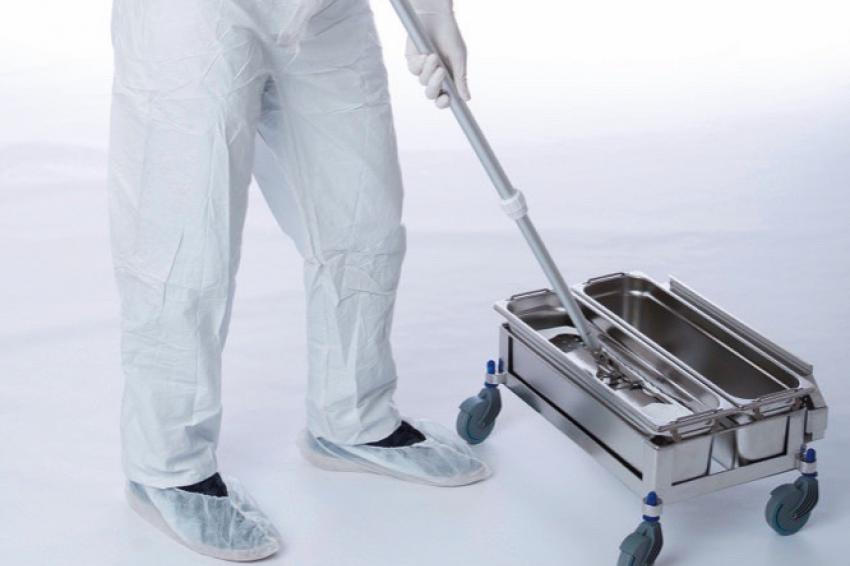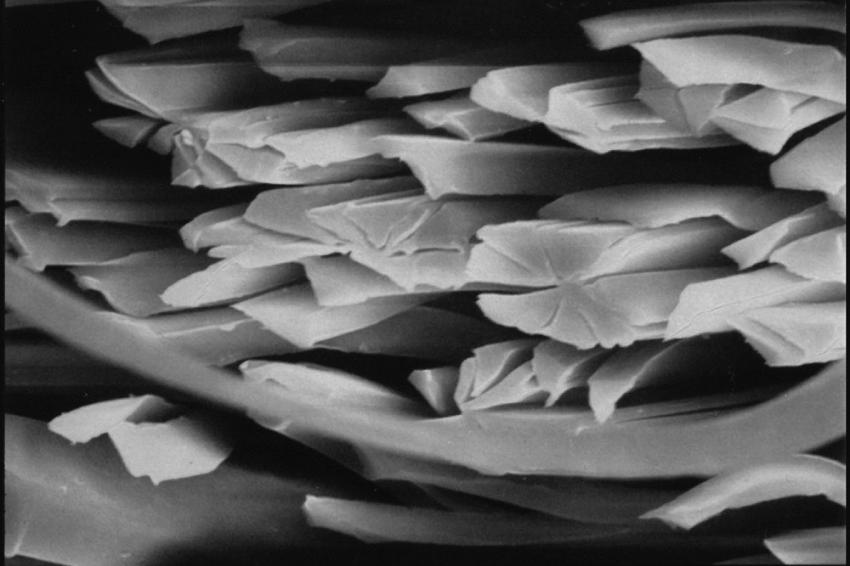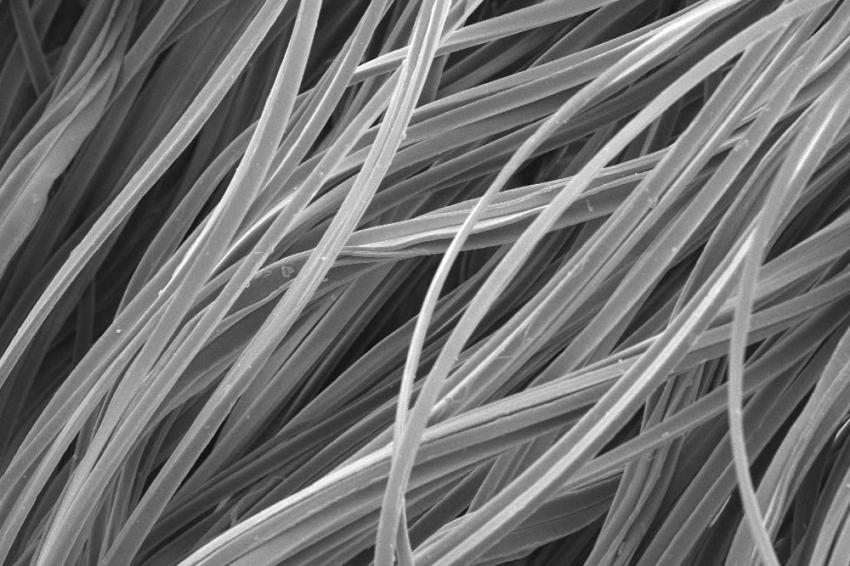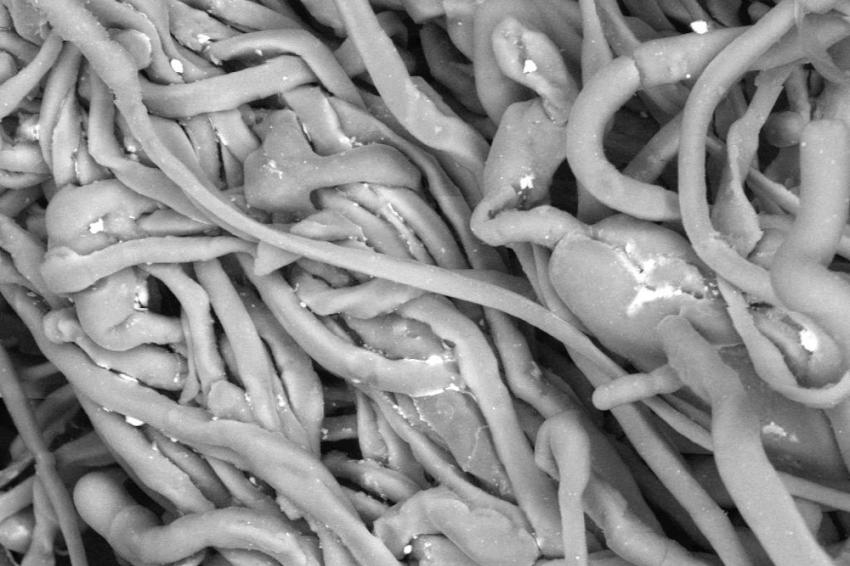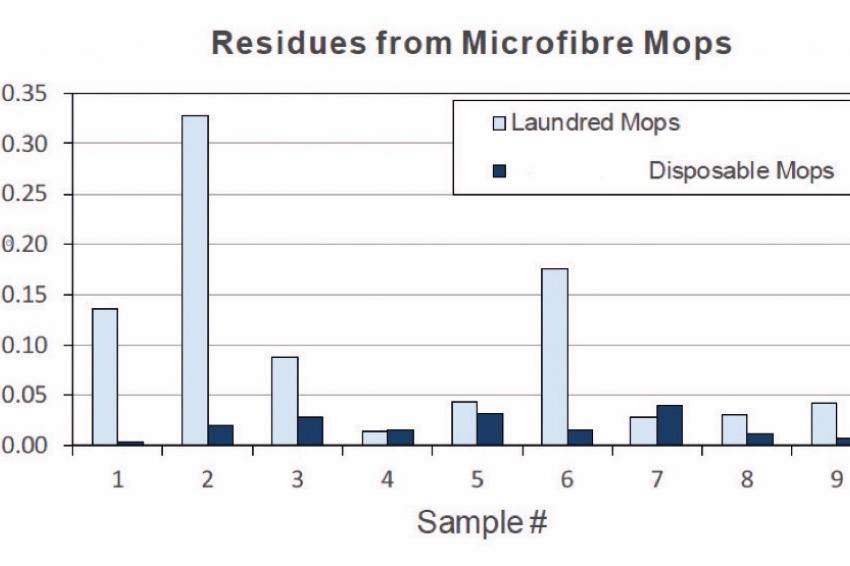The hidden problems with relaundering microfibre mops
28.01.2019 - Best practice for both wipes and mops in a cleanroom environment is to use single-use disposable products.
This reduces the risk of cross contamination and ensures that contamination is physically removed from the cleanroom environment at the end of a session. However, more and more facilities are laundering and re-using mops as a potential cost saving alternative to single use disposable products. A quick internet search of reusable cleanroom mops shows that many of these mops are manufactured from microfibre yarns.
Even the smallest cleanroom facility will spend tens of thousands of pounds on cleanroom consumables in a year, in a large facility the consumable spend will run into hundreds of thousands of pounds. According to Transparency Market Research the cleanroom consumables market is expanding at a steady CAGR of 4.15 % between 2017 and 2023, to a valuation of $11,316 m by 2023. However, careful consideration needs to be given as to whether the reuse of mops, especially microfibre mops can lead to a reduction in consumable quality which could subsequently lead to contamination of a final product or a reduction in yield.
In the late 1980’s microfibre was introduced. The definition of a microfibre is a fibre with less than 1 decitex per filament. A decitex is a measure of linear density that is commonly used to describe the size of a filament or fibre. One decitex is 9/10th of a denier. To put this into perspective it is less than the diameter of a silk strand or about 1/16th the diameter of a human hair. The tiny fibres are combined to create yarn which can be knitted or woven into a variety of constructions. Microfibre fabrics can be broken down into two main types, splitable microfibre and straight filament microfibre.
Straight filament microfibres tend to be made from 100% polyester. Splitable microfibre consists of very fine threads of polyester and polyamide (nylon) that are combined to form a single thread. The nylon is used to glue the tiny fibres together until they are split later in the process. Split microfibre possesses numerous wedges rather than the rounded threads found in non split yarns. It is these wedges that provide the ability to collect microscopic particles off a surface. This expanded surface area and the capillary action of the fine threads dramatically increases a microfibre wipes sorbancy.
A change in the percentage of the microfibre blend will yield slightly different properties. This split structure gives the wipe the ability to pick up particles even when dry and can easily remove residues often without solvent. The split fibres create microscopic spaces which collect and hold dust, dirt and particles more effectively than rounded fibres such as cotton.
The microfibres are also positively charged so electrostatically attract the negatively charged dirt. Microfibre has a high sorptive capacity around 6 to 8 times its own weight in water. The fast wicking ability means a wipe can remove spills quickly and easily, so it is very suitable for mop to dry situations.
The increased use of microfibre mops
This high level of sorbency and ability to pick and up and trap small particles in the structure has led to the increased use of microfibre mops in cleanroom environments. Microfibres are less durable than standard filaments and create much higher levels of fine particle contamination. The microfibre needs to initially be laundered to reduce these levels of contamination, to be suitable for use in a cleanroom. This level of processing coupled with the cost of the microfibre yarn itself means the majority of cleanroom 100% microfibre mops are too costly for single use, so need to be laundered, re-sterilised and re-used, to be a cost-effective option. This process typically involves a contract with an external industrial laundry and if a sterile product is required either an autoclave process or an irradiation provider also.
Risks of relaundering microfibre
The process of relaundering and where relevant the re-sterilisation, cleanroom mops is not without risk. Microfibre is very delicate and can be easily damaged by high heat or harsh chemicals, this can lead to a mop or wipe degrading over time and affecting both the cleaning ability and the sorbent capacity of the mop. Laundries use mechanical, thermal and chemical processes in washing and drying which can cause irreversible damage to the delicate microfibre structure.
The key properties that make a microfibre product such a good cleaning tool, also makes them nearly impossible to be cleaned. The fine filaments and delicate fibre structure are designed to gather and hold dirt, organic matter and microbes; it is extremely challenging to consistently remove those contaminants in each successive laundry cycle. So, the laundry facility is left with a paradox — either subject the products to effective laundry conditions that damage the cleaning efficiency of the fibres or protect the products from degradation by minimizing the harshness of laundry treatment conditions and then risk incomplete cleaning and disinfection of the mop.
Contec Study
Contec’s Healthcare team looked into this paradox in more detail and published their findings in a white paper, Clinical Advantages of Disposable Microfibre Mops. The study compared hospital relaundered microfibre mops with a disposable microfibre product. Microfibre mops were examined microscopically before and after laundering to visualize the impact of the laundry process, the levels of organic and inorganic residues trapped in the microfibre structure were examined microscopically before and after relaundering, the impact of the residual organics on subsequent quat binding was determined, the bioburden on the mops after laundering was quantified and finally the actual cleaning efficacy of the relaundered mop versus a disposable mop was quantified in a patient room using ATP analysis.
Although the parameters in this study are not all directly applicable in to a cleanroom environment, especially in terms of bioburden collected, some of their findings are relevant and need to be considered.
Visual and microscopic analysis
The effects of repeated laundering can sometimes be obvious to the naked eye especially with coloured mops. This visual degradation would be picked up if the customer has specified a rigorous inspection routine for the mops as they go through the relaundering process. However, the scanning electron microscope analysis highlighted the unseen damage that is occurring. Pictures attached show the dramatic difference between “new” microfibre and microfibre that had been “in the system” for just a few laundry cycles. As previously mentioned, the fine nature of the synthetic microfibres make them susceptible to damage and the laundering process is harsh, with chemicals, heat, abrasion all playing a part in the cleaning and drying process. The laundered fibres appear distorted and melted together, this can result in decreased performance in terms of sorbency and ability to hold particles and microbes. Particulate contamination not removed by laundering (or introduced during the laundering process) are evident as white specks.
Residues in the mops
As well as particles it is possible that the laundry process is ineffective in removing trapped residues of the disinfectant or detergent solution. This can be easily measured be soaking the mop in clean water and then squeezing the extract into a clear clean beaker. If the resulting water is dirty, cloudy or contains suds then the laundry process has failed to sufficiently remove all the trapped chemical residue.
To compare residuals from laundered re-usable mops versus disposable mop pads, an extraction test was conducted on 18 samples (nine laundered re-usable microfibre mops and nine new microfibre pads) using the recommended practice published by the Institute of Environmental Sciences and Technology. Samples of each mop were taken only from the microfibre fabric portion. The laundered microfibre mops had an average residual level of 0.099 ± 0.102 gm-2 whereas the average residues from disposable microfibre mops were nearly five times lower (0.020 ± 0.012 gm-2) and exhibited much lower variability among the nine samples.
Impact of trapped residues on binding and inactivation of disinfectants
The retention of organic particulates and residues in laundered mops can cause issues when the mops are returned into use. Disinfectants and sporicides are very reactive and can either readily bind to organic materials or be deactivated by them; whether they are living or not. If the mop head is contaminated with residual detergents or organic debris left over after laundering, the mop head itself can bind or inactivate the disinfectant chemistry before it ever touches the surface to be disinfected. Examples of a similar reaction have been demonstrated in previous studies where quaternary ammonium disinfectants (“quats”) readily bind to cotton (cellulose) based cleaning wipes and mops. This type of reaction also can occur with the residual organics in laundered synthetic mop heads.
To quantify this binding effect, the study compared using laundered mops vs. disposable microfibre mops with a common quaternary ammonium (quat) based disinfectant. Both mops were immersed in a 1000 ppm commercially available quat solution for 0.5 to 60 minutes. After removing the mops the residual amount of active disinfectant on the mop was measured and also the amount of active disinfectant applied to a prepared surface. Not unsurprisingly, the level of active disinfectant available decreased by 20% within the first minute of exposure to a laundered microfibre mop. More interesting though was the concentrations in solution continued to decrease with the longer exposure times. Within 15 minutes, the levels in solution contacting the mop had dropped below the level required for disinfection.
With the disposable microfibre mop, the level of active quat in solution also decreased during initial exposure to the mop. However, unlike with the laundered product, the concentration of active disinfectant stabilized after one minute and remained at effective levels throughout the duration of the study. The levels of active quat recovered from the stainless steel coupons were lower than the levels from the mops, but the same trends were observed between disposable and laundered mops. These results indicate that residual organic matter can impact the efficacy of disinfectants when applied with re-laundered microfibre mops.
Summary
The use of disposable mops is very straightforward: a new mop is used to clean a specified area (floors, walls, etc.), then downgraded (for use in less critical areas), or discarded outright after the primary use. The surface area cleaned per mop is determined by sampling of critical metrics, and validated if the area is sterile. The amount of particles and fibres shed by the mop is assessed using by laboratory work provided by the manufacturer. The ability of the mop to apply a validated disinfectant for a validated contact time is assessed and documented. This same initial testing and validation is carried out for a reusable mop.
Since disposable mops are made from new materials to a validated process they provide a consistent and predictable performance and result. This result remains constant even over a long period of time as a new mop with the same parameters is used every time. As shown by the study above the affect relaundering has on a microfibre mop can lead to the performance and quality of the mop changing over time due to the inevitable degradation of the reused mop. The laundry process can cause irreversible damage to the delicate microfibres structures that are essential for cleaning and the retention of particles and / or residue can detrimentally affect the efficacy of disinfectants used.
For the evaluation of a reusable mop project, it is necessary to project the performance and quality over time in order to estimate the life cycle and therefore related costs of the mops. As the actual quality, contamination profile, and performance of reusable mops will deviate over time, such deviation could result in unintended and potentially unacceptable risk to the customer’s environment and subsequently product. Understanding the real risk of using reusable mops can only be accomplished through repeated periodic revalidation over the period of relaundering and the costs for that repeated validation factored in. The decision on whether to use disposable versus laundered reusable mops may boil down to a simple question: “Do you really know the mop you’re using?"
Author:

